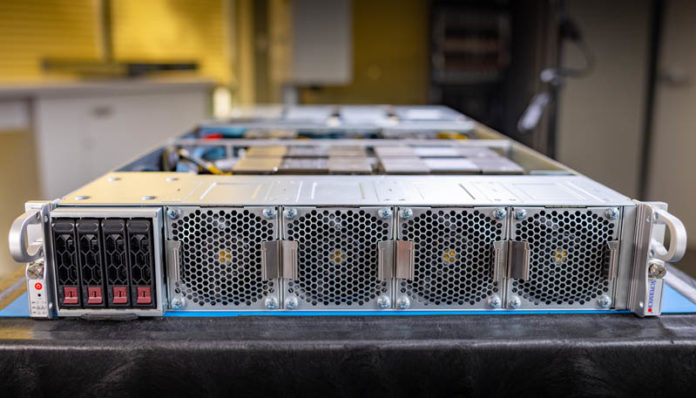Today we are looking at the Supermicro SYS-220GQ-TNAR+ that Patrick recently got some hands-on time with at Supermicro headquarters. This 2U server hosts a quartet of NVIDIA SXM4 HGX A100 GPUs on a dual-socket 3rd generation Intel Xeon Scalable CPU platform. The NVIDIA platform is codenamed “Redstone” and is popular for HPC-style applications. These are usually hard to get time with given the current industry environment, so we always take the chance when we get it.
Video Version
This is part of our visit to the Supermicro HQ series, similar to our recent coverage of the Supermicro Hyper-E 2U.
We are going to have more detail in this article, but want to provide the option to listen. As a quick note, Supermicro allowed us to film the video at HQ, provided the systems in their demo room, and helped with travel costs to go do this series. We did a whole series while there and are tagging this as sponsored. Patrick was able to pick the products we would look at and have editorial control of the pieces (nobody is reviewing these pieces outside of STH before they go live either.) In full transparency, this was the only way to get something like this done, including looking at a number of products in one shot, without going to a trade show. Look for more in this series coming to STH over the coming weeks.
Redstone on Intel
STH has looked at NVIDIA Redstone platforms in the past, such as when we looked at the Dell PowerEdge XE8545, but our previous encounters have been based on AMD platforms. Supermicro’s solution is significantly denser than Dell’s since it is a 2U platform, making one able to put twice the GPUs and CPUs in a rack versus what Dell offers. That is a big deal in the HPC space. As a reminder to our readers, NVIDIA Redstone refers to the quad SXM4 NVIDIA GPU assembly, also called the “HGX A100 4-GPU” interconnected via NVLink. The SXM4 form factor for the NVIDIA A100 GPUs allows a significantly higher power budget to be fed to the GPUs than any PCIe-slot form factor would allow.
The SYS-220GQ-TNAR+ differentiates itself from previous Redstone systems we have looked at by the use of 3rd gen Intel Scalable processors. For some workloads, the AVX-512 support, DL Boost, and the monolithic die architecture has benefits over AMD’s architecture so having this option is important in the industry. We will just note that Supermicro also has the AMD version, we just wanted to look at an Intel version to see something different.
Supermicro SYS-220GQ-TNAR+ Overview
The front of the SYS-220GQ-TNAR+ is dominated by four high throughput fan modules.
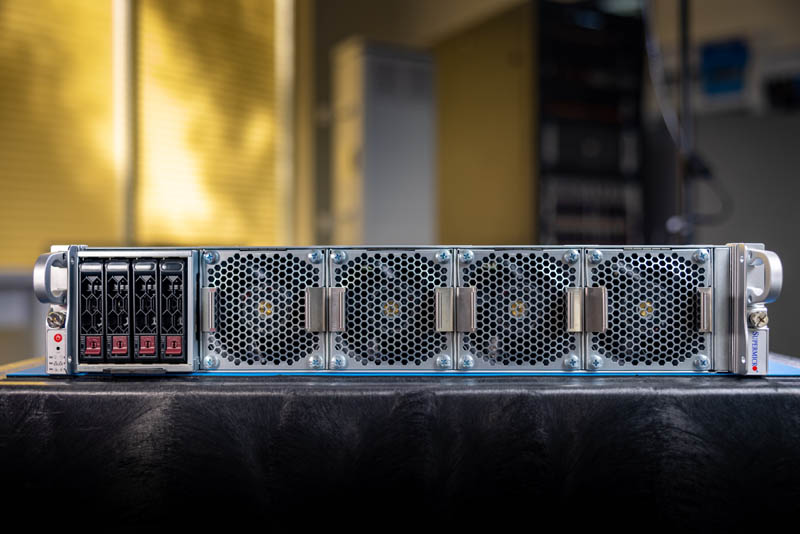
These extremely high output fans are responsible for cooling all four A100 GPUs and both Xeon CPUs, so the large hot-swap fan modules are to be expected. Something that we did not expect is that the fans actually have little flaps. In the video, you can see these being moved (one advantage over static photos.)
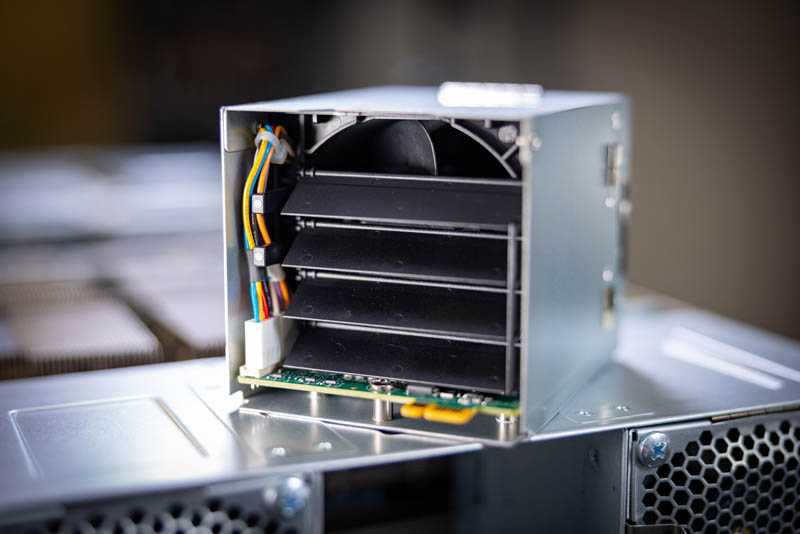
Also located up front are 4x 2.5″ SATA hot-swap bays. The small portion of the front of the server allocated to storage visually tells the story that storage is not a key concern with this platform.
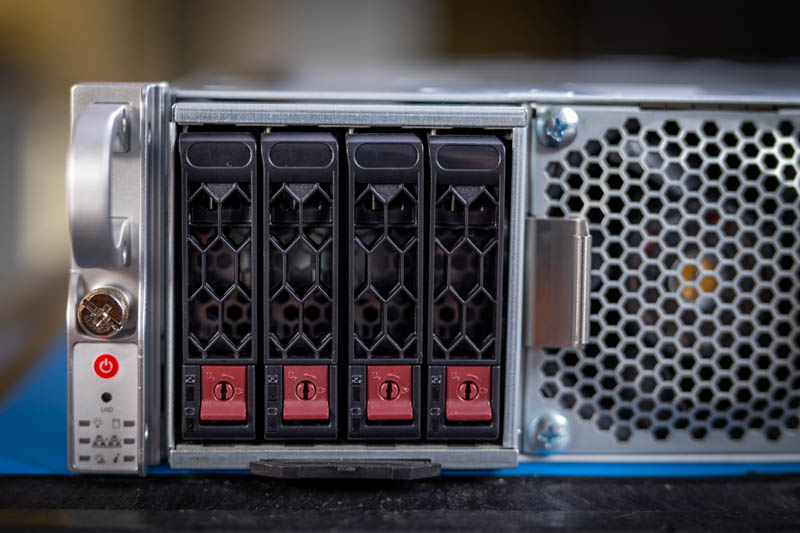
Around the back of the server, we have a perhaps more typical-looking rear for a 2U server.
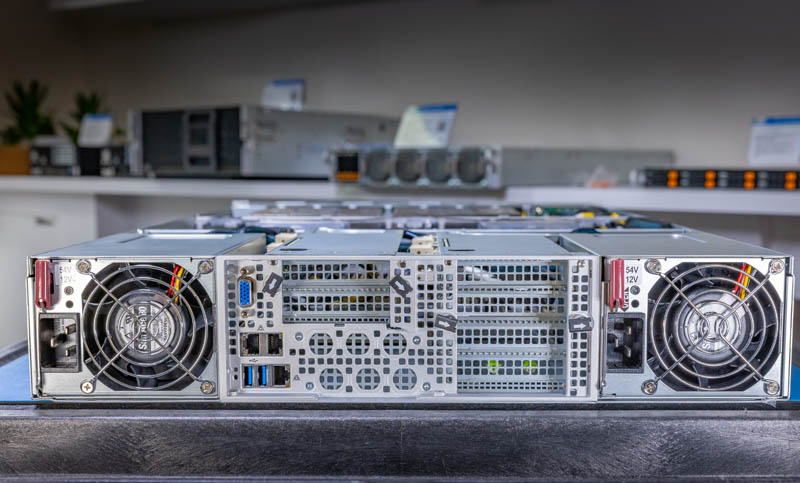
Your normal system I/O is included here, with a pair of 10 GbE network ports, a dedicated BMC port, and USB and VGA outputs. In addition, six low-profile slots appear on the rear of the chassis; the SYS-220GQ-TNAR+ includes connectivity for four low-profile PCIe 4.0 x16 slots. In addition, tucked behind the expansion slots on the right are a pair of NVMe/SATA compatible M.2 slots.
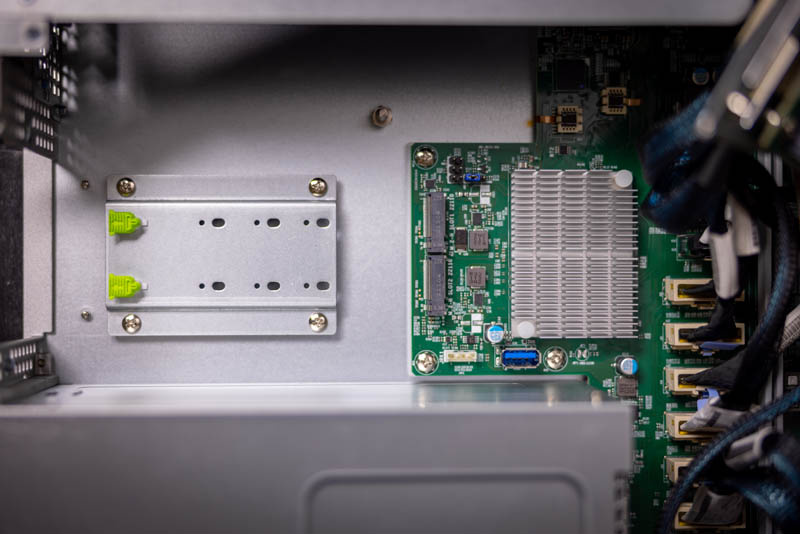
Something that is a bit unique here is that the M.2 slots have spring-loaded retention mechanisms for tool-less swapping. These mechanisms also are mounted directly to the chassis instead of over the motherboard. That is a way that Supermicro is able to save some motherboard space but it requires tighter chassis integration.
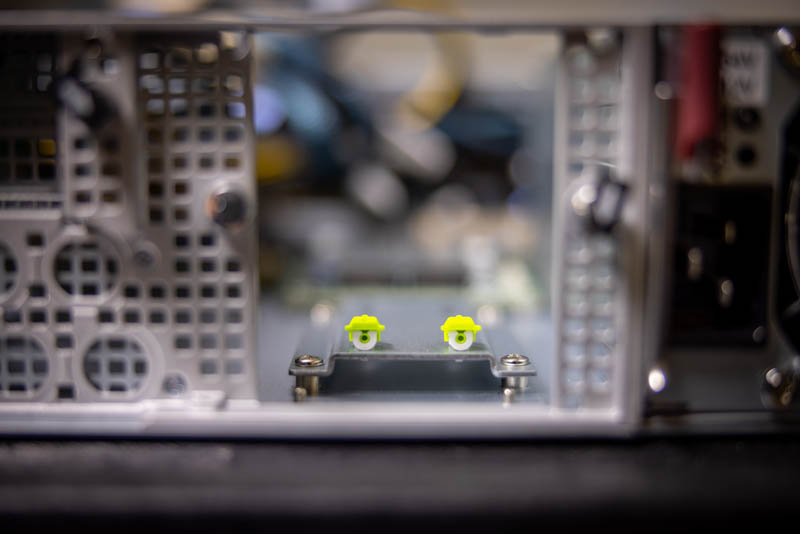
Flanking all of the normal rear I/O and expansion slots are a pair of heavy duty power supplies.
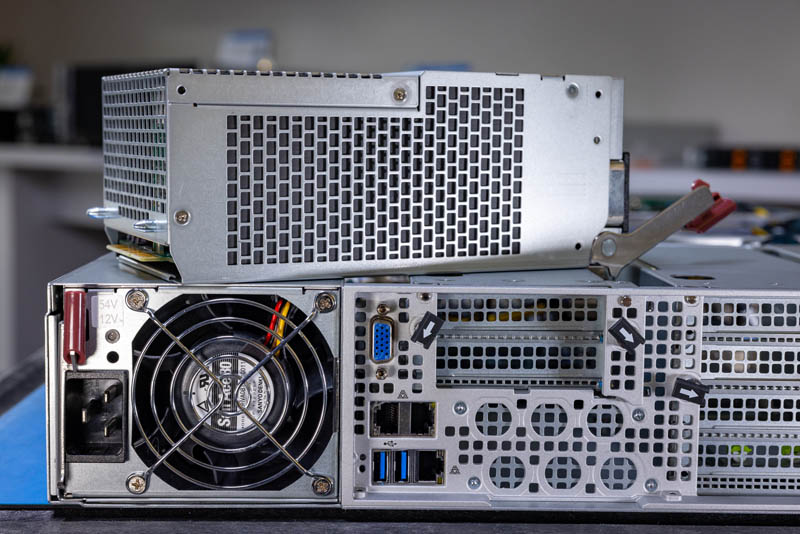
These are both 3000W 80Plus Titanium units, and they have the potential to get quite a workout from this server. Thanks to the amount of power draw these units can pull, these supplies will not operate on 120V and instead require 207V-240V power.
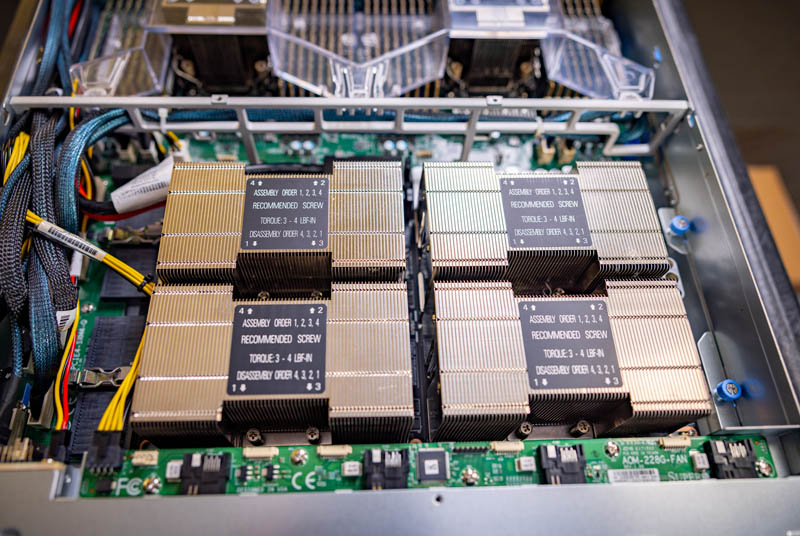
The key feature of this server is NVIDIA’s Redstone GPU configuration. A quartet of SXM4 form-factor HGX A100 GPUs with PCIe 4.0 CPU-to-GPU connectivity and NVLink GPU-to-GPU interconnectivity. The SXM4 form-factor allows for additional power delivery over what a PCIe slot can deliver, with 400W being supplied to each A100 module. This amount of power generates a good bit of heat, hence the gigantic heatsinks we have come to associate with this platform. Of course, this also can draw a ton of power necessitating those huge power supplies we just saw.
One of the really interesting things that we also saw in the demo room, was the latching mechanism between the Supermicro platform and the NVIDIA GPU assembly. Here is what that looks like without the cables installed. One can see the data connections on high-density connectors secured by a large latch. There are headers for cables providing PCIe connectivity to the system. This is part of the way that Supermicro can make a modular system that can have either AMD or Intel options.
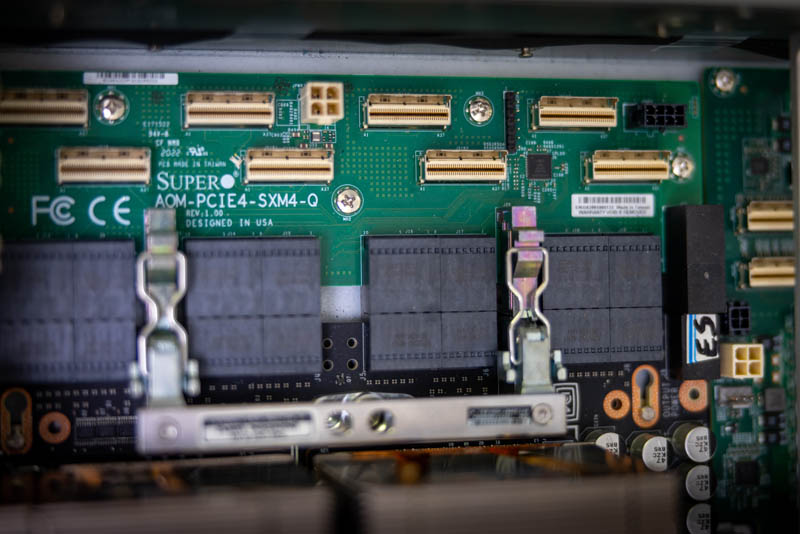
We are also just going to quickly note that one can see the six liquid cooling input holes on the rear I/O plate. We are specifically looking at the 400W air-cooled version here, but Supermicro has other options available.
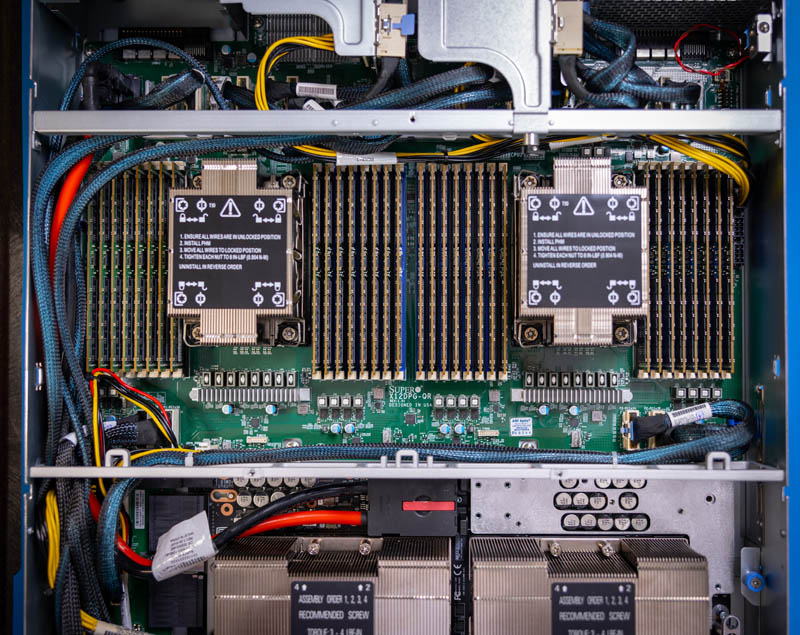
Tucked behind the GPUs we see a dual-socket Xeon Scalable solution. The server accepts 3rd Generation Ice Lake CPUs at up to 40 cores per socket. These CPUs can have up to 270W TDP, which when combined with the thermal output of the GPUs can represent a ton of heat in a relatively small 2U package. Flanking the CPUs are 32x memory slots that can accept up to 32x 256GB DDR4 sticks at up to 3200 MHz and attach to 8-channel memory controllers on the CPUs. As an option, this system can slot in up to 16x Intel Optane PMem 200 512GB sticks if the workload calls for it. Finally, thanks to the Ice Lake platform all of the PCIe connectivity on this server operates at PCIe 4.0 speeds, which brings parity to previous AMD-powered Redstone platforms.
Final Words
The Supermicro SYS-220GQ-TNAR+ represents an interesting option in the NVIDIA GPU server market. Specifically, it is something different for the HGX A100 4-GPU “Redstone” platform. This system brings Intel-specific offerings like Optane PMem 200 support and AVX-512 acceleration to the Redstone market, and gives buyers an AMD alternative for their GPU servers. Again, Supermicro has AMD versions as well, we just wanted to show that there are other options given our previous coverage.
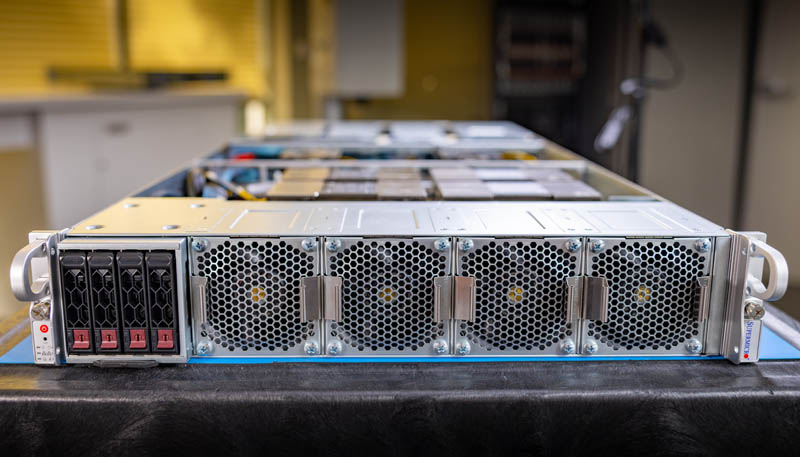
Once again, a big thank you to Supermicro for letting Patrick poke about their demo room. There are still more interesting systems that he was able to get his hands on, so keep an eye out for those in the near future!

